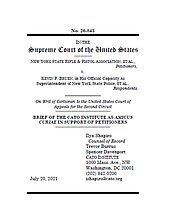Learn more about Cato’s Amicus Briefs Program.
More than a decade ago, the Supreme Court declared that the Second Amendment guarantees an individual right to keep and bear arms for self-defense. Since then, lower courts have tried to restrict the right as much as possible.
New York prohibits its citizens from carrying a handgun outside the home without a license. And while New York permits concealed carry of a handgun with a license, it makes it virtually impossible for citizens to obtain a license because it requires every citizen to have a “proper cause” to carry a firearm. Under New York law, a general desire to protect oneself does not meet the “proper cause” threshold. Relying on an earlier case, the Second Circuit blessed this licensing regime. Petitioners appealed, and the Supreme Court agreed to take the case.
The Second Circuit is not anomalous in its treatment of the Second Amendment. The morass of case law since District of Columbia v. Heller is wildly divergent and unintelligible. While Heller used a history-based inquiry, lower courts have adopted a variety of judge-empowering balancing tests. The only thing consistent across circuits is judges upholding all but the most severe restrictions under the guise of “public safety.”
The Supreme Court is not blameless in the lower courts’ malfeasance. Though Heller resolved the question of firearms in the home, it expressly declined to say how the ruling should apply in other contexts. Moreover, the Court has consistently declined to hear challenges to other restrictive gun regulations. Thus, the Court’s decision to hear the case is significant because the ultimate decision will likely set the standard for how all Second Amendment cases are handled going forward.
Because of this, Cato has filed an amicus brief, detailing the slipshod way in which Second Amendment claims have been handled in the various courts of appeals throughout the country since Heller. Our brief shows how courts have evaluated the Second Amendment under a watered-down form of intermediate scrutiny—unthinkable in any other constitutional context. Cato urges the Supreme Court to use this case to establish clear rules for evaluating Second Amendment claims. Specifically, we recommend the test laid out in Heller, which was based on constitutional text, history, and tradition. That test will allow lower courts to better evaluate Second Amendment claims consistently while affording the right to keep and bear arms the proper respect an enumerated constitutional right deserves.

This work is licensed under a Creative Commons Attribution-NonCommercial-ShareAlike 4.0 International License.


